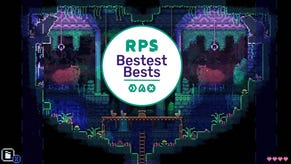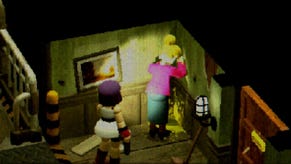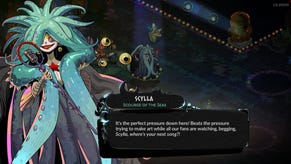Wot I Think: Songbringer
Music to your ears
I find Songbringer [official site] absolutely fascinating. It's like the fragmented remains of a game, carefully discovered and pieced together as you play. A stunningly beautiful conflation of pixel graphics and intricately complex lighting effects, creating a fractured and intense look, presenting a combination of action RPG and rogue-ish exploration of a wonderfully detailed yet procedurally generated world. What you're doing, why you're doing it, how best to do it - that's what I'm putting together the more I play. Here's wot I think:
The short of it is, you play a dude with a sword, and then an ever-growing collection of interesting weapons (not least the boomerang-like golden top hat you wear), accompanied by a floating orb being, trying to clear out screen after screen of interconnected locations filled with a huge variety of enemy types. But it's not nearly as arcadey as that makes it sound - it's a much more considered game, in many ways, asking you to meticulously clear an area to leave it safe, while searching for the few quests the barren world offers, and underground dungeons of far higher difficulty to clear out.
At the start you're asked if you want to play a regular mode, or a permadeath mode, the latter being - I would venture - something for the hardest of cores. Because the regular mode does something more interesting with death - it resets all the cleared locations to be filled with enemies again.
That's hardly unique, but the way it plays out here offers something - I think - much more interesting than just starting again. You keep your progress, your gathered weapons, your count of diamonds used as currency in the peculiar totemic underground shops. But there's a significant blow to having all the paths from one task to another refilled, and it's something that becomes more impacting the further into the game you get. It offers a similar sense of importance to not failing in a particular moment as a rogue-like, but allows the game to better deploy its RPG story.
Combat is a mixture of melee and ranged, and a frantic time in many screens, dependent upon the enemy type. What most gets me here is the complete indifference many of the enemies have to you, and yet their ability to do real damage. There are some, like the hordes of leaping yellow bugs, that jump about at random and yet have the capacity to take chunks out of you when you're clipped. There are others, like the ghastly glowing porcupine things that actively try to attack you. And there's are others still, like the teeny little elephants, that just trundle about seemingly unaware of you, yet when trying to dispatch them, you'll find that their unpredictable movements can make for a surprising challenge. Meanwhile many screens feature water, and water means the bobbing dragon beasties that throw green orbs directly toward you.
Underground dungeons feature a much tougher range of enemies, including ghoulish humanoids with much more specific and dangerous attacks, or the absolutely hateful lizard bastards that get me nearly every time. And while dying in a dungeon only resets you to the entrance with its handy save, it still means you know everything you'd cleared up top will be repopulated. It makes taking on dungeons a real gamble, and there are many that have proven too tough for me with my current levels of health and attack abilities - I note them down to return to later.
The map gradually fills in as you explore, marked with elusive symbols to remind you what is where. Green squares mean there's something important to find over there, and oftentimes it can be a little labyrinthine in its layout, making exploration and survival key. And I'm constantly having to remind myself that the map, as fantastic and specific as it seems to be, is a random generation based on a seed I created by typing in random letters. CJRPPW, should you wish to play the exact same game as me.
I think it's hard to underplay just how successfully the seeded world feels coherent and complete - something on which a lot of procedurally generated games can easily fall short.
I began saying how wonderful the graphics are, but I want to repeat it. It's very easy to sigh at the sight of pixel graphics at this point, because they're in every other game. But here the design shines so damned brightly, not least thanks to lighting effects that deserve piles of awards. But it's also thanks to the incredible detail therein, the vivacity and life put into the incredible animations, the weather effects, and the enemy variety. Combine that with the uncomfortably brilliant music, and it exudes a deliberate and unsettling atmosphere that perfectly suits the tone.
Oh, and leave the game on the title screen and it runs little demo versions, like games used to and still should. Huzzah.
It's just constantly splendid fun, ever-changing and interesting, with increasingly challenging dungeons to keep you wanting to improve. I love how it drips in its scant story in peculiar little cutscenes or flashbacks, how little moments of conversation are always exquisitely well written, sometimes oddly poetic.
I've not finished it, because curses those lizard men are tough, so I can't yet speak for length and conclusion, but the fact that I could just start a second game with a different seed and play it all through differently is enormously appealing. It's not the deepest game, but it's smart, ridiculously pretty, and has me completely hooked.
Songbringer is out on September 1st for Windows, Mac and Linux, via Steam and GOG.












